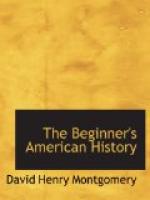59. The Dutch take possession of the land on the Hudson and call it New Netherland; how New Netherland became New York.—As soon as the Dutch in Holland heard that Captain Hudson had found a country where the Indians had plenty of rich furs to sell, they sent out people to trade with them. Holland is sometimes called the Netherlands; that is, the Low Lands. When the Dutch took possession of the country on the Hudson (1614), they gave it the name of New Netherland,[3] for the same reason that the English called one part of their possessions in America New England. In the course of a few years the Dutch built (1615) a fort and some log cabins on the lower end of Manhattan Island. After a time they named this little settlement New Amsterdam, in remembrance of the port of Amsterdam in Holland from which Hudson sailed.
After the Dutch had held the country of New Netherland about fifty years, the English (1664) seized it. They changed its name to New York, in honor of the Duke of York, who was brother to the king. The English also changed the name of New Amsterdam to that of New York City.
[Footnote 3: New Netherland: this is often incorrectly printed New Netherlands.]
60. The New York “Sons of Liberty” in the Revolution; what Henry Hudson would say of the city now.—More than a hundred years after this the young men of New York, the “Sons of Liberty,” as they called themselves, made ready with the “Sons of Liberty” in other states to do their full part, under the lead of General Washington, in the great war of the Revolution,—that war by which we gained our freedom from the rule of the king of England, and became the United States of America.
The silent harbor where Henry Hudson saw a few Indian canoes is now one of the busiest seaports in the world. The great statue of Liberty stands at its entrance.[4] To it a fleet of ships and steamers is constantly coming from all parts of the globe; from it another fleet is constantly going. If Captain Hudson could see the river which bears his name, and Manhattan Island now covered with miles of buildings which make the largest and wealthiest city in America, he would say: There is no need of my looking any further for the riches of China and the Indies, for I have found them here.
[Footnote 4: In her right hand Liberty holds a torch to guide vessels at night.]
61. Summary.—In 1609 Henry Hudson, an English sea-captain, then in the employ of the Dutch, discovered the river now called by his name. The Dutch took possession of the country on the river, named it New Netherland, and built a small settlement on Manhattan Island. Many years later the English seized the country and named it New York. The settlement on Manhattan Island then became New York City; it is now the largest and wealthiest city in the United States.




